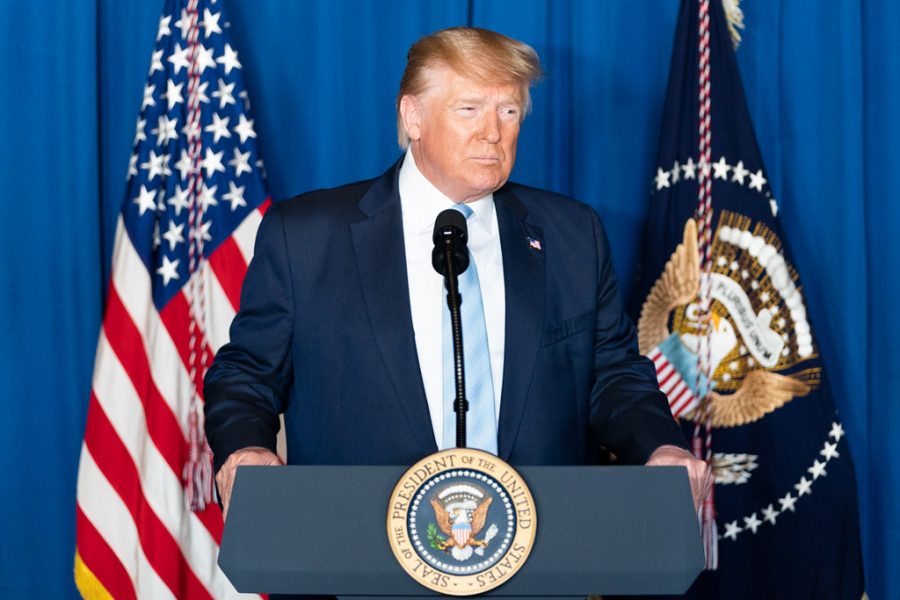Mistrust over Trump’s views, speeches and executive orders high among Americans
Anxiety high among parents with many schools reopening.
President Donald J. Trump delivers remarks during a press conference Friday, Jan. 3, 2020,
August 13, 2020
Despite President Trump attempting to assure everyone involved that reopening schools for fall semester would be safe, even as new coronavirus cases continued to rise last month, many educators and hundreds of school districts have reversed course and decided to continue remote learning to start the school year.
According to a New York Times article, the infection rates were a major factor for most districts when deciding to continue using remote learning. Many educators were not convinced by Trump’s aggressive approach for reopening schools. In many cases, it apparently served to reinforced their concerns that reopening would be unsafe unless stronger safety measures were met.
Recent polls have indicated that parents and educators have lost trust in the president’s aggressive efforts to move ahead with in-person classes. A July poll taken by Education Week found that roughly 60% of educators said the pandemic had worsened their view of Trump. A recent Washington Post poll found that two-thirds of parents disapprove of Trump’s handling of school reopening. A new Gallup poll also shows that fewer parents want their children to return to school buildings now than they did in the spring.
LeeAnne Power Jimenez, the vice president of the Tulsa Classroom Teachers Association and a member of the state union’s Republican caucus said she was “frustrated” by Trump’s approach to reopening, which she characterized as more focused on the economy than on teachers’ health and safety, according to the NYT article.
Teachers “need to hear that our lives are important,” Jimenez said.
There is widespread agreement across most of the political spectrum that a functional economy requires working schools. But even conservatives who agree with the push to reopen schools, say Trump has been a poor spokesperson for the cause.
Rick Hess, the director of education policy at a conservative think tank called the American Enterprise Institute, characterized how badly the president’s strategy backfired.
“If you had told me that Trump was doing this as a favor to the schools-must-not-open crowd, I’d believe you,” Hess told the New York Times.
According to the NYT article, a common concern among educators is that millions of low income children and students with disabilities will suffer disproportionately without in-person instruction, while wealthier families are arranging home-schooling pods and tutors to make up for the sizable gaps left by distance learning.
Health officials such as Dr. Anthony Fuaci, director of the National Institute of Allergy and Infectious Diseases, said recently that he believed children in cities and states with low infection rates “can get back to school with the kinds of precautions that you do in general society.” according to the NYT article.
Nataliya Braginsky, a high school teacher who teaches African American and Latinx history and facilitates workshops in anti-racist curriculum and pedagogy development in a public school in New Haven, Conn., wrote a perspective piece claiming that Black, Indigenous and Latinx students would see more deaths from COVID-19 in their schools than white students.
In the piece, Braginsky points to unequal funding, environmental racism, and toxic stress to which students of color are exposed to more than white children.
Braginsky notes that maintaining six feet distance would not be possible if bus capacities are not reduced and class sizes remain as large as 27 students per class.
She also compares the public school where she has taught for seven years, where the windows do not open, to the private school in nearby Hamden, where some of the school’s students will be relocated to a recently purchased castle so social distance will be possible.
“This public vs. private school disparity is just one piece of a much larger puzzle of educational injustice,” Braginsky writes. “Federal funding, which Education Secretary Betsy DeVos and President Trump recently threatened to cut if schools do not fully reopen, make up the smallest percentage. In Connecticut, 58 percent of school funding comes from local property taxes. This all but guarantees that a young person raised in a city whose property values are lower will attend a school with less funding than a child raised in a town with higher property values.”
Braginsky brings up the racial disparities in coronavirus infection and mortality rates that Black and Latinx people face, saying that the causes are directly linked to inequality in housing, employment, transportation and health care, all of which are reinforced by racism.
“Black and Latinx people are three times more likely than white people to become infected, and twice as likely to die of coronavirus,” Braginsky said. “While the picture is incomplete for Indigenous people, who are being left out of data collection — and further compromised as the Trump administration orders hospitals to cease reporting data to the CDC — it is clear that infection and death rates are also disproportionately high in Native communities.”
She writes how in schools, “it’s no different — and this injustice precedes the pandemic.”


